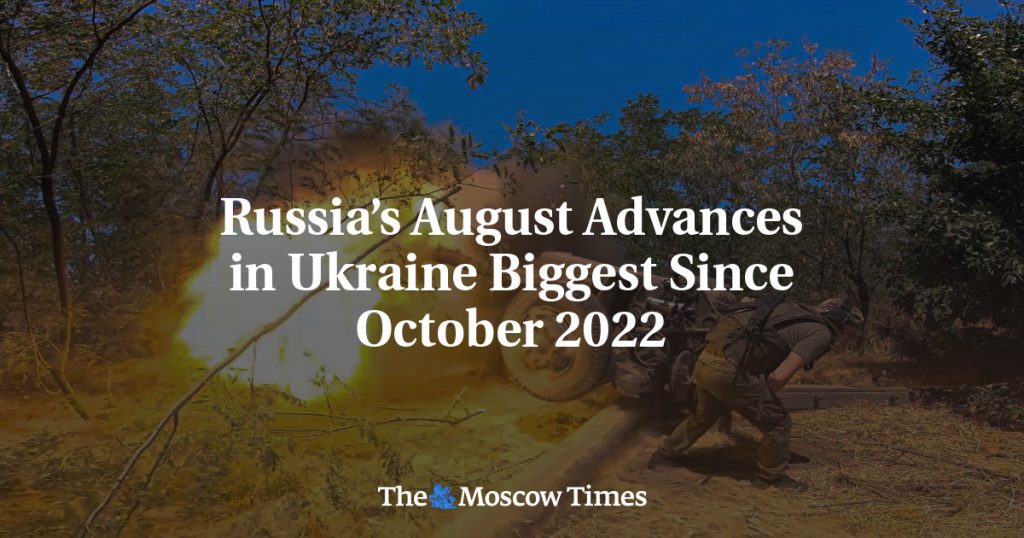In August, Russia made significant advances on Ukrainian territory, gaining 477 square kilometers, the largest monthly increase since October 2022. The Ukrainian army also made gains in early August, with rapid progress into Russia’s border region of Kursk, acquiring over 1,100 square kilometers in two weeks. However, the front has now stabilized, with advances of between 1,150 and 1,300 square kilometers over the past 15 days, mostly in Donetsk. Russian troops were advancing at a rate of 15 square kilometers per day, predominantly towards the logistical hub of Pokrovsk, coming within less than seven kilometers of the city by late Sunday.
This recent territorial expansion by Russia is reminiscent of their actions in October 2022, which was in response to a major Ukrainian counteroffensive around Kharkiv. Since the beginning of 2024, Moscow has once again begun pushing into Ukrainian territory, gaining 1,730 square kilometers, three times more than in 2023. Unfortunately, Ukrainian forces have struggled to counterattack on their own territory, with only eight days in 2024 where they won more territory from Russia than they lost. As of September 1, Russia occupied 66,266 square kilometers of Ukrainian territory, including Crimea and zones of eastern Ukraine under pro-Russian separatists’ control before the 2022 invasion, covering 18% of Ukraine’s 2013 size.
While Russia’s recent advances in Ukraine have been significant, Ukrainian forces have managed to make gains in early August before the front stabilized in Donetsk. The pace of Russian advancement, at 15 square kilometers per day, has put them within close proximity to the city of Pokrovsk. Moscow’s renewed push into Ukrainian territory in 2024 has resulted in a substantial increase in gains compared to previous years, with Ukrainian forces struggling to counterattack effectively on their own territory. The occupation of 66,266 square kilometers of Ukrainian territory by Russia, including Crimea and zones controlled by pro-Russian separatists, represents a significant portion of Ukraine’s total landmass.
The situation in Ukraine remains complex, with Russia making significant territorial advances and Ukrainian forces struggling to counterattack effectively. The recent stabilization of the front in Donetsk, with advances of 1,150 to 1,300 square kilometers over the past 15 days, indicates a potential period of consolidation and fortification for both sides. Russia’s current occupation of Ukrainian territory, including Crimea and zones controlled by pro-Russian separatists, covers a substantial portion of Ukraine’s 2013 size. The recent advances by both Russian and Ukrainian forces in 2024 have once again highlighted the ongoing conflict and the challenges facing Ukraine as it attempts to defend its territory.
The conflict in Ukraine has seen recent escalations in territorial gains by both Russian and Ukrainian forces, with Moscow making the largest monthly increase since October 2022. Despite initial rapid gains by Ukrainian forces in early August, the front stabilized in Donetsk, with Russian troops advancing towards Pokrovsk at a rate of 15 square kilometers per day. Ukrainian forces have struggled to counterattack effectively on their own territory, with only eight days in 2024 where they won more territory from Russia than they lost. Russia’s occupation of 66,266 square kilometers of Ukrainian territory, including Crimea and zones controlled by separatists, represents a significant portion of the country’s landmass.
As of September 1, Russia had advanced 477 square kilometers into Ukraine, the largest monthly increase since October 2022. Ukrainian forces made significant gains in early August but struggled to maintain momentum, with the front solidifying in Donetsk and Russian troops advancing towards Pokrovsk. Moscow’s renewed push into Ukrainian territory in 2024 has resulted in substantial territorial gains, with Ukrainian forces finding it difficult to counterattack effectively. The occupation of 66,266 square kilometers of Ukrainian territory by Russia, including Crimea and zones controlled by pro-Russian separatists, covers a considerable portion of Ukraine’s landmass. The ongoing conflict highlights the challenges facing Ukraine as it seeks to defend its territory against Russian advances.


